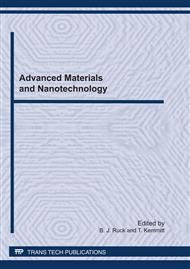p.203
p.207
p.211
p.215
p.219
p.223
p.227
p.231
p.236
Improvement of BTEX Adsorption Using Silylated RH-MCM-41 Synthesized from Rice Husk Silica
Abstract:
RH-MCM-41, a mesoporous molecular sieve, was successfully synthesized from silica extracted from rice husk. The presence of silanol functional group (Si-OH) on its surface causes adverse effects on the adsorption of some non-polar compounds, especially benzene, toluene, ethylbenzene and xylene (BTEX). Thus, this work aims to enhance the adsorbability of RH-MCM-41 on BTEX adsorption by in-situ and ex-situ silylation. Trimethylchlorosilane (TMCS) was used as a silylating reagent to reduce silanol groups. The ex-situ silylation was carried out by adding as-synthesized RH-MCM-41 into 5% v/v of TMCS solution at 30°C and stirring for 24 h. While the in-situ silylated sample was prepared by mixing 5% v/v of TMCS solution and RH-MCM-41 precursor solution at 80°C and stirring for 120 h. The adsorption capacity of gaseous BTEX using the silylated RH-MCM-41 was determined by gas chromatography equipped with a flame ionization detector (GC-FID) with a thermal desorption unit (TDU). The adsorption capacities of the ex-situ samples were 0.617 mg g-1 for benzene, 1.271 mg g-1 for toluene, 1.902 mg g-1 for ethylbenzene and 0.036 mg g-1 of xylene, higher than that of the in-situ and the unsilylated samples. Thus, the ex-situ silylation is suitable for enhancement of hydrophobicity of RH-MCM-41. The ex-situ silylated RH-MCM-41 has the potential to be applied in gaseous BTEX treatment.
Info:
Periodical:
Pages:
231-235
Citation:
Online since:
September 2011
Authors:
Keywords:
Price:
Сopyright:
© 2012 Trans Tech Publications Ltd. All Rights Reserved
Share:
Citation:


